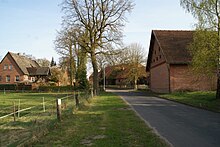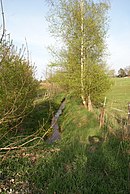Belsen (Bergen)
|
Belsen
City of Bergen
Coordinates: 52 ° 47 ′ 9 ″ N , 9 ° 56 ′ 12 ″ E
|
|
|---|---|
| Height : | 63 (56-66) m |
| Residents : | 331 |
| Incorporation : | 1st February 1971 |
| Postal code : | 29303 |
| Area code : | 05051 |
Belsen is a town in the city of Bergen in the northern district of Celle in the Lüneburg Heath in Lower Saxony and has 331 inhabitants (as of December 31, 2000).
geography
The original old village of Belsen is about 3 kilometers southwest of Bergen . In the south of the village a large new building area has formed. To the west, right next to Belsen, are the barracks of the Bergen military training area . The Bergen-Belsen concentration camp was located about three kilometers southwest of the old, original village of Belsen . The memorial with the area of the former prisoner of war and concentration camp and the Bergen-Belsen Concentration Camp Documentation Center, newly built in 2007 , now largely belong to the area of the municipality of Winsen (Aller) , district of Walle .
Between Bergen and Belsen is the ramp where the displaced people had to leave the freight wagons and walk the remaining 4 km to the concentration camp.
The ramp is now used to load military vehicles that are transported by train for exercises on the Bergen-Hohne NATO firing range by British , Dutch , French , German , Belgian , Luxembourg or Polish armed forces .
history
Belsen was first mentioned in a document in 1235 under the name Bellenhusen.
In 1935 the boundaries of the Bergen military training area were determined and the expansion began. First Belsen, Hoppenstedt and Hörsten was a camp for one in the area of Local Infantry - Division built. In the district of Celle, the planned purchase of the area and the resettlement of the residents began. The resettlement began in the summer of 1935 and the area had to be cleared by May 1, 1936. From the municipality of Belsen, which originally had a size of 2100 hectares with 209 inhabitants, 1460 hectares with 118 inhabitants fell into the area of the military training area.
On February 1, 1971, Belsen was incorporated into the city of Bergen.
The Bergen-Belsen Working Group supports the work of the Bergen-Belsen Memorial with its voluntary participation.
politics
Since its incorporation as part of the Lower Saxony district and administrative reform Belsen is since 1971 the village of Bergen . Belsen is represented by the local council and the local mayor. The local council has u. a. Decision-making authority for the public institutions in the village, is responsible for promoting the maintenance of the townscape and club life and must be heard by the city of Bergen on all matters relating to the town. It is made up of five elected representatives, members of the Bergen City Council from Belsen and the Mayor of Bergen City.
The local council elects the mayor , the incumbent is Hagen Rodehorst.
Culture and sights
See also architectural monuments in Belsen
literature
- Friedrich Barenscheer u. a., Bauernbuch , undated (around 1935). In: Bergen City Archives
- Collection of sources for the local history of Belsen , in. Bergen city archive
- Hinrich Baumann: The Heidmark - Change of Landscape: The History of the Bergen Military Training Area. ISBN 3-00-017185-1 .
- Lehnsbriefe on enfeoffment of the Belsen mill , (from 1554), in: Bergen City Archives
Web links
Individual evidence
- ^ Federal Statistical Office (ed.): Historical municipality directory for the Federal Republic of Germany. Name, border and key number changes in municipalities, counties and administrative districts from May 27, 1970 to December 31, 1982 . W. Kohlhammer GmbH, Stuttgart and Mainz 1983, ISBN 3-17-003263-1 , p. 223 .
- ↑ Information on the Lower Saxony municipal constitution







